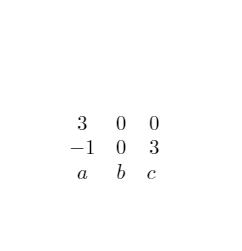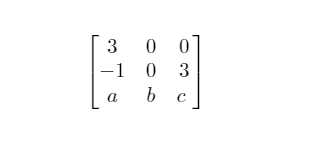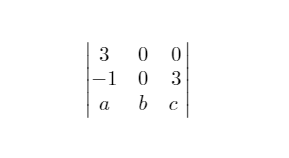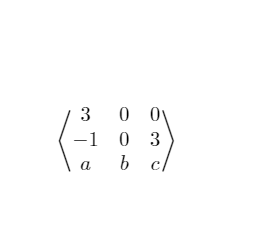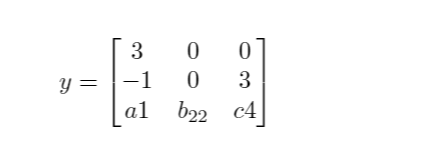This tutorial discusses how to write matrices using LaTeX.
How to Write and Render Matrices in LaTeX
To write and render matrices in LaTeX, you need to import the amsmath package. You do this in the preamble as:
LaTex Matrices Environments
Once you import the amsmath package, you get access to various types of environments to create matrices.
The following are the matrices’ environment variables.
- Matrix – Does not include any enclosing symbols
- pmatrix – Uses parenthesis to enclose values in the matrix
- bmatrix – this environment uses square brackets to enclose the matrix
- Bmatrix – Uses curly braces to enclose the matrix.
- vmatrix – the small v environment uses single pipes to enclose the values.
- Vmatrix – Use double pipes.
How to Write Various LaTex Matrices
The following shows how to write various matrix types in LaTeX.
How to Create the No Braces Matrix
To write a matrix with no braces, we use the matrix environment as shown in the example code below:
\usepackage[utf8]{inputenc}
\usepackage{amsmath}
\begin{document}
$$\begin{matrix}
3 & 0 & 0 \\
-1 & 0 & 3 \\
a & b & c \\
\end{matrix}$$
\end{document}
The example code above creates a 3 x 3 matrix as shown in the image below:
How to Create the Parenthesis Matrix
To enclose a matrix with parenthesis, use the pmatrix variable. Here is an example code:
\usepackage[utf8]{inputenc}
\usepackage{amsmath}
\begin{document}
$$\begin{pmatrix}
3 & 0 & 0 \\
-1 & 0 & 3 \\
a & b & c \
\end{pmatrix}$$
\end{document}
The result of the matrix code above is:
How to Create the Square Brackets Matrix
Using the bmatrix environment, you can create a square bracket matrix as shown in the example code below:
\usepackage[utf8]{inputenc}
\usepackage{amsmath}
\begin{document}
$$\begin{bmatrix}
3 & 0 & 0 \\
-1 & 0 & 3 \\
a & b & c \
\end{bmatrix}$$
\end{document}
How to Create Curly Braced Matrix
You can also use the Bmatrix environment to create a curly braced matrix. Here is an example code:
\usepackage[utf8]{inputenc}
\usepackage{amsmath}
\begin{document}
$$\begin{Bmatrix}
3 & 0 & 0 \\
-1 & 0 & 3 \\
a & b & c \
\end{Bmatrix}$$
\end{document}
How to Create Single Pipes Matrix
To create a matrix with single pipes as the delimiters, use the vmatrix environment. Here is an example code for that:
\usepackage[utf8]{inputenc}
\usepackage{amsmath}
\begin{document}
$$\begin{vmatrix}
3 & 0 & 0 \\
-1 & 0 & 3 \\
a & b & c \
\end{vmatrix}$$
\end{document}
How to Create Double Pipes Matrix
To use double pipes uses the Vmatrix environment. Example:
\usepackage[utf8]{inputenc}
\usepackage{amsmath}
\begin{document}
$$\begin{Vmatrix}
3 & 0 & 0 \\
-1 & 0 & 3 \\
a & b & c \
\end{Vmatrix}$$
\end{document}
How to Create Custom Delimiters
You can also use LaTex delimiters to create a custom matrix. For example, to use angles as the delimiters,
\langle for left angle and \rangle for the right angle.
An example code is illustrated below:
\usepackage[utf8]{inputenc}
\usepackage{amsmath}
\begin{document}
\left\langle
\begin{matrix}
3 & 0 & 0 \\
-1 & 0 & 3 \\
a & b & c
\end{matrix}
\right\rangle
\end{document}
Once you compile the code, you should get a matrix in the form:
Working With Inline Matrices
If you try to include an inline matrix using the regular matrix environments, you will notice that it does not render correctly.
To resolve this, you can use a small matrix.
For example:
\usepackage[utf8]{inputenc}
\usepackage{amsmath}
\begin{document}
Maths is awesome with small matrices $\big(\begin{smallmatrix} a & b\\ c & d \end{smallmatrix}\big)$ as that one.
\end{document}
Once compiled, it should fit in line with other content as:
Assigning Matrices
Suppose you want to assign a value to a matrix. To do this, you can use the equation environment as shown:
\usepackage[utf8]{inputenc}
\usepackage{amsmath}
\begin{document}
\begin{equation*}
y = \begin{bmatrix}
3 & 0 & 0 \\
-1 & 0 & 3 \\
a1 & b_{{22}} & c4
\end{bmatrix}
\end{equation*}
\end{document}
Once you compile the code above, you should get an equation matrix as shown.
Conclusion
Matrices are very useful in technical documentation. Hence, having a simple way to create them in LaTex can help save time and create easy-to-understand documentation.

